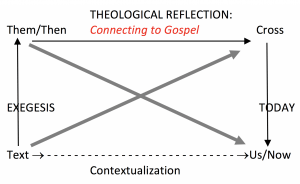I love getting to be an occasional instructor at Simeon Trust Women’s Workshops for three reasons in particular. One, I always come away with the sense that I learned more than I taught. Two, I get a better handle on foundational aspects of teaching the Bible rightly by teaching others to do it. I love to sit around the table with six women who have all been working in the text, who are all committed to helping each other get better in our Word work. Three, I get to work with Colleen McFadden, director of women’s workshops for The Charles Simeon Trust. I appreciate her passion for God’s Word and her skill in helping others learn how to handle it.

In this episode of Help Me Teach the Bible, McFadden and I talked about a diagram she often uses that demonstrates something important about teaching the Bible—the need to work from the text to understand what the original author intended the original audience to know, and to travel from there through the cross before we apply the text to our audience. We also discussed the need to develop a clear argument so that our Bible teaching will not merely be a loose collection of ideas.
Is there enough evidence for us to believe the Gospels?
 In an age of faith deconstruction and skepticism about the Bible’s authority, it’s common to hear claims that the Gospels are unreliable propaganda. And if the Gospels are shown to be historically unreliable, the whole foundation of Christianity begins to crumble.
In an age of faith deconstruction and skepticism about the Bible’s authority, it’s common to hear claims that the Gospels are unreliable propaganda. And if the Gospels are shown to be historically unreliable, the whole foundation of Christianity begins to crumble.But the Gospels are historically reliable. And the evidence for this is vast.
To learn about the evidence for the historical reliability of the four Gospels, click below to access a FREE eBook of Can We Trust the Gospels? written by New Testament scholar Peter J. Williams.
































